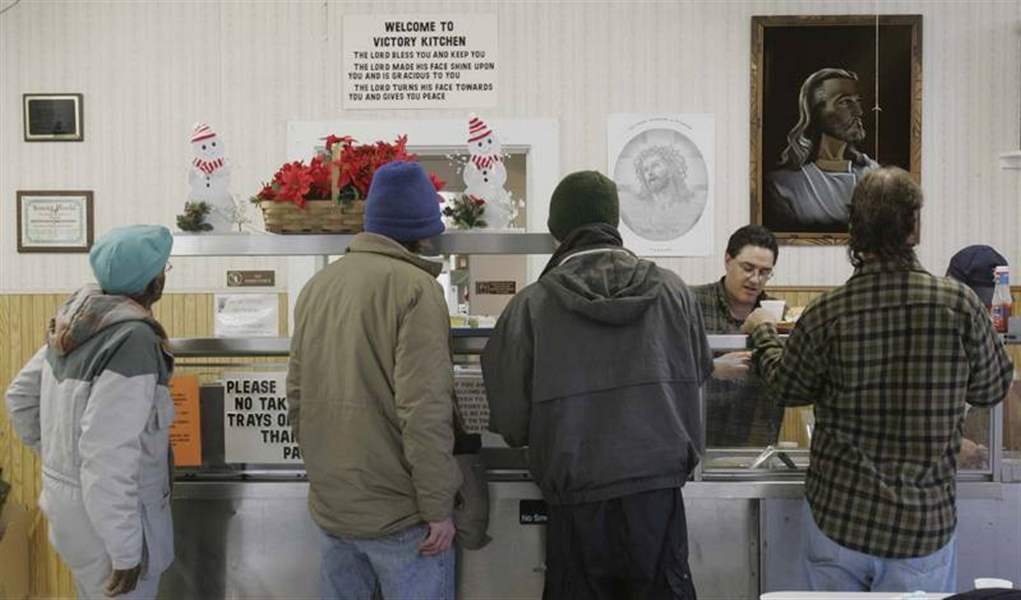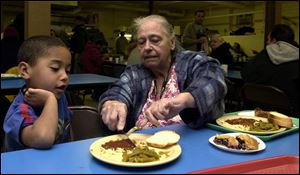
Going hungry in Ohio and Michigan: Soup kitchens find need outpaces resources
12/4/2005
Glenn Gardner, a volunteer from Castalia, Ohio, serves meals at the Victory Temple Soup Kitchen in Sandusky.

Kenny Johnson, 4, and his great-grandmother, Joyce Doss, eat at the Helping Hands of St. Louis soup kitchen in East Toledo. Ms. Doss takes him there to ensure he gets a hot meal because her Social Security check often isn't enough to make ends meet.
SANDUSKY - Ed Brutsche used to have a full-time job at a plastics factory and dreams of a middle-class life.
"Then my car broke down and I missed a couple days and got fired," the Sandusky man said while eating a lunch of beef pot pie, sweet potatoes, and broccoli at the Victory Temple Soup Kitchen.
Mr. Brutsche, 50, now works part-time as a janitor and shares an efficiency apartment with a friend, Ted David, who is a part-time restaurant dishwasher. Without the soup kitchen, Mr. Brutsche said, "I don't know what I'd do. Live on peanut butter and jelly sandwiches, I guess."
Mr. Brutsche and Mr. David, 43, both regular visitors to the Hayes Avenue soup kitchen, said they've noticed bigger crowds in the past several months.
"I see more and more people here," Mr. Brutsche said. "We kind of cry on each other's shoulder and share fellowship."
Operators of Victory Temple and other soup kitchens and food pantries in northwest Ohio say a loss of factory jobs and surging utility costs are sending growing numbers of people to their doors. The increase in demand, coupled with a drop in donations, is straining some of those charities' budgets.
"We're doing our very best to manage what we've got and hold these doors open," said Nancy Walters, who directs the Victory Temple kitchen with her husband, the Rev. Lonnie Walters.
The couple reduced the soup kitchen's lunch schedule from five days a week to three in October because of spiraling expenses for heat, electricity, and food. The kitchen also stopped paying its full-time secretary.
Mrs. Walters said a $100,000 donation to the charity four years ago has sustained operations since then, but that money is almost gone. Just $11,000 is left to support the facility, which has an annual budget of $114,000.
Donations have dropped because of Ohio's continuing economic woes and competition for donations from charities assisting victims of Hurricane Katrina. "We feel the ripple effect of it," she said. "The same thing happened after 9/11. Everything went to New York."
The recession that gripped the nation after the Sept. 11, 2001, terror attacks is still being felt among the region's emergency food providers and their clients.
While overall unemployment in the region seems to be easing, Ohio and Michigan continue to bleed factory jobs, and poverty remains high.

Glenn Gardner, a volunteer from Castalia, Ohio, serves meals at the Victory Temple Soup Kitchen in Sandusky.
Ohio's unemployment rate fell from 6.2 percent in October, 2004, to 5.9 percent in October, 2005. In Lucas County, the jobless rate dropped from 6.7 percent to 6.2 percent.
In Michigan, unemployment stood at 6.1 percent in October.
But from 1998 to 2003, 16 northwest Ohio counties and three southeast Michigan counties together lost nearly 23,400 manufacturing jobs, or 13 percent of their factory work, the U.S. Census Bureau reported.
From 2001 to 2004, Ohio's poverty rate rose from 11 percent to 12.2 percent. In Michigan, poverty increased from 9.4 percent to 13.5 percent.
Mr. Brutsche and Mr. David said full-time jobs are getting harder to find in Sandusky, which has been hit with a wave of plant closings and layoffs. "The way it is around here, everything's part-time right now, because all the factories have closed down," Mr. David said.
Despite the kitchen's money troubles, Mrs. Walters and her husband restored the old lunch schedule last week.
"We decided that with the weather being the way it is, that we were going to open up five days a week," she said. "The donors we have, they expect us to be open five days a week."
As for the future, Mrs. Walters said she and the facility's volunteers are relying on the kindness of donors to keep them in business. "We know if the Lord's willing, everything's going to get back to normal," she said.
James Caldwell, director of the Toledo Northwestern Ohio Foodbank, said demand for groceries is surging at the 330 agencies he works with in the food bank's eight-county service area.
"The feedback that we get from those agencies is that the need is pervasive, and that a lot of people have lost their jobs or are fearful of losing their jobs," he said.
At Helping Hands of St. Louis in East Toledo, the program's staff has been forced to cut some aid programs to focus on providing food to needy families.
"We're staying afloat," said charity director Paul Cook, who has worked for Helping Hands since 2001. "When I first started here, we had funds that we could sometimes help people with their utilities. That's no longer available. Now, it's just about keeping food on the table and keeping the facility open."
Helping Hands is busy enough just providing meals. From December, 2004, through last month, the east-side kitchen served 72,000 meals, up from 65,000 meals for the same period a year earlier, Mr. Cook said.
"The number's been escalating every year," he said. "We see people losing their jobs or their benefits being cut. We have a lot of working poor in the area who are just barely getting by."
At noon Wednesday, Kenny Johnson, 4, joined his grandmother, Dawn Case, and great-grandmother, Joyce Doss, for a meal of spaghetti, green beans, applesauce, and bread in St. Louis' basement dining room.
Kenny lives with Ms. Doss, 66, who supports herself, the boy, and his 7-year-old sister on her Social Security benefits and some small child-support payments. Ms. Doss said her income is just over the cutoff for food stamps, and that she brings Kenny to St. Louis to ensure he gets a healthy lunch. Otherwise, she said, "He would just have snacks in the afternoon. He wouldn't have a real meal."
Mr. Cook said Helping Hands has sustained its food-service program, which includes lunch on weekdays and breakfast three times a week, because of private donations and federal grants.
Other charity food distributors haven't been so lucky.
Lisa Hamler-Fugitt, executive director of the Ohio Association of Second Harvest Foodbanks, said some of the food pantries that work with her organization have closed after running out of money and food. Most are in rural areas such as southeast Ohio.
"Once you get outside of the well-resourced areas, the urban areas, you really start to see significant food shortages," she said. "A lot of us who have been doing this work for a number of years keep saying it can't get any worse, and every time we turn around it gets worse."
Angie Franklin knows all too well the challenges of trying to feed poor people from rural communities. Ms. Franklin is program director at the Northwestern Ohio Community Action Commission, which operates the Richland Place/PATH Center soup kitchen in Defiance.
It's the only such facility in Defiance, Fulton, Henry, Paulding, and Williams counties.
Ms. Franklin said that before this year, meal crowds averaged 25 to 30 people but lately those numbers have nearly doubled.
Surveys of agency clients in 2003 and this year showed nutrition topping their list of needs.
"People in our community are really struggling with food," she said. "What many of them told us is that after they finish paying their bills, there's not enough money left to buy food."
Ms. Franklin said the soup kitchen has met the demand because of generous food donations from its service area and government funding.
At the Good Samaritan Outreach Center in Toledo's south end, individual cash donations are down more than 25 percent this year.
"There's been a definite drop-off," said Greg Shapiro, president of the center's board of directors. He attributed the donation decline to last year's Asian tsunami and Hurricane Katrina: "I think people are getting tapped out."
Good Samaritan serves breakfast and lunch weekdays to about 200 people a day. "We put out a hot meal twice a day, and people are lined up at our door when we open," he said.
Mr. Shapiro said he expects demand to keep rising, but he has faith his center can meet the need. "It's certainly challenging, but we're doing what the Bible tells us to do, which is to feed the poor," he said. "So God always provides. Somehow, we keep the doors open."
Contact Steve Murphy at: smurphy@theblade.com or 419-724-6078.